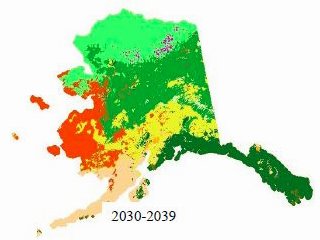SAN DIEGO, April 6, 2011 -- Dr. Falk Huettmann, a wildlife ecologist and professor at the University of Alaska-Fairbanks, has written a report entitled Future of Alaska in which he forecasts how climate change, human activities, natural disasters and cataclysmic events might affect Alaska's ecosystem over the next 100 years.
The report presents a range of possible futures and scenarios based on real data that land managers, government agencies, communities, businesses, academics and non-profits can assess. By providing a unique and useful way to evaluate how climate change, habitat change and consumption impacts Alaska's ecosystems, the report will guide those concerned in making better management and sustainability decisions for oceans, wildlife, endangered species and humans alike.
 Dr. Huettmann was required to analyze and examine over 400 species of animals, innumerable plant species, diseases and wildly diverse landscape biomes (including arctic tundra, coastal tundra plains, mountain and alpine areas), deciduous forests, arboreal forests, coastal rainforests and the interior. The large number of variables, the nonlinear interactions and the ungainly size of the compiled database proved too complex for ordinary predictive modeling software programs.
Dr. Huettmann was required to analyze and examine over 400 species of animals, innumerable plant species, diseases and wildly diverse landscape biomes (including arctic tundra, coastal tundra plains, mountain and alpine areas), deciduous forests, arboreal forests, coastal rainforests and the interior. The large number of variables, the nonlinear interactions and the ungainly size of the compiled database proved too complex for ordinary predictive modeling software programs.
We used a 'climate envelope' approach to develop predictive models for distribution of the different modeling subjects at three future time-steps in the next century: 2030-2039, 2060- 2069, 2090-2099. We used decadal averages of the Composite GCM climate data at each time step to avoid selecting extreme low or high years. We used only the climate data (temperature and precipitation) for the months of December and June. After exploring several options, Dr Falk Huettmann selected RandomForest® (Salford Systems) as the primary modeling tool to define the current climate envelope for each modeling subject then to define where on the landscape those same climate envelopes exist in the future.
Dr. Huettmann explained, "RandomForests is extremely well-suited to handle data based on GIS, spatial and temporal data. It delivers the high degree of accuracy and generalization required for our study, something other solutions couldn't achieve because of the immense size of the database and the statistical interactions involved. It achieves this with amazing speed"
For details, see Connecting Alaska Landscapes into the Future, A collaborative strategic habitat conservation project, by: Falk Huettmann and Research Team
For more information, visit www.salford-systems.com
